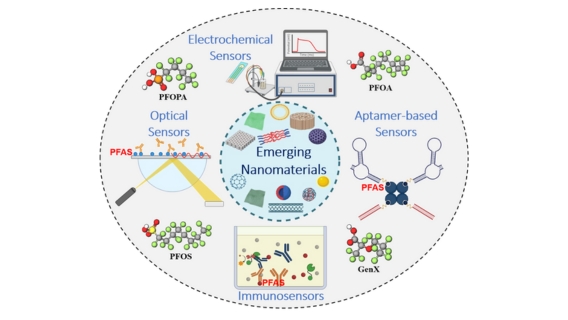 PFAS represent a class of synthetic chemicals that are being used in modern society, found in various consumer products, industrial processes, and environmental matrices. Their widespread applications have led to alarming contamination levels globally, with studies estimating detection in the blood of 98% of the citizen of USA. Exposure of PFAS have been to cancer, immune system dysfunction, and developmental abnormalities. The extent of contamination could be seen in drinking water sources, agricultural soils, and wildlife habitats. Urgent action is imperative to mitigate PFAS pollution, safeguard ecosystems, and protect public health, emphasizing the critical need to detect PFAS in the limits in the the US EPA set legally enforceable drinking water limits in the range of parts per million (PPT).
PFAS represent a class of synthetic chemicals that are being used in modern society, found in various consumer products, industrial processes, and environmental matrices. Their widespread applications have led to alarming contamination levels globally, with studies estimating detection in the blood of 98% of the citizen of USA. Exposure of PFAS have been to cancer, immune system dysfunction, and developmental abnormalities. The extent of contamination could be seen in drinking water sources, agricultural soils, and wildlife habitats. Urgent action is imperative to mitigate PFAS pollution, safeguard ecosystems, and protect public health, emphasizing the critical need to detect PFAS in the limits in the the US EPA set legally enforceable drinking water limits in the range of parts per million (PPT).

Current technologies of chromatographic approach for PFAS detection suffer drawbacks such as higher detection limits, limited analyte range, longer analysis times, and the need for laborious derivatization processes. Significantly, many PFAS compounds are present in the environment at low concentrations, often in parts per trillion levels. This article presents emerging nanosensor technologies for directly applying in PFAS sensors, offering improved detection capabilities and enabling real-time monitoring of PFAS levels in different environmental settings. Basically, the review delves into the forefront of PFAS nano-sensor engineering, elucidating advancements in optical, electrochemical, aptamer-based, and immune-based nanosensors. By taking an integrated approach, the review comprehensively addresses current challenges and future potentials in PFAS nanosensor fabrication, outlining critical development objectives and the encountered hurdles. This holistic analysis aims to guide future research endeavours towards strategic improvements in PFAS detection technology, offering researchers and practitioners synthesized knowledge to facilitate the development of innovative and efficient PFAS-detecting systems and their transfer into the industrial practice.
Ajith M. Parambil, Eepsita Priyadarshini, Shounik Paul, Aristeidis Bakandritsos, Virender K. Sharma, Radek Zbořil, Emerging Nanomaterials for Per- and Polyfluorinated Substances Detection. J. Mater. Chem. A, 2025, 13, 8246-8281, DOI: 10.1039/D4TA07045C





